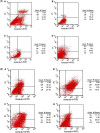The anti-tumor effect of Newcastle disease virus HN protein is influenced by differential subcellular targeting
- PMID: 20130861
- PMCID: PMC11030028
- DOI: 10.1007/s00262-010-0821-5
The anti-tumor effect of Newcastle disease virus HN protein is influenced by differential subcellular targeting
Abstract
Background: Immunotherapy is emerging as a major player in the current standard of care for aggressive cancers such as non-small cell lung cancer (NSCLC). The Newcastle disease virus with its tumor-specific replicative and oncolytic abilities is a promising immunotherapeutic candidate. A DNA vaccine expressing the major immunogenic hemagglutinin-neuraminidase (HN) protein of this virus has shown promising results as an immunotherapeutic agent.
Methods: In the present study, three different DNA vaccine constructs encoding differentially targeted HN proteins (cytoplasmic or Cy-HN, secreted or Sc-HN and membrane-anchored or M-HN) were generated to evaluate their anti-tumor effect in vitro and in vivo.
Results: Although all three DNA constructs elicited an immune response, tumor-bearing mice intratumorally injected with M-HN demonstrated a significantly better anti-tumor effect than those injected with Cy-HN or Sc-HN. We also showed that this anti-tumor effect was mediated by higher lymphocyte proliferative response and CTL activity in mice intratumorally injected with M-HN.
Conclusion: The membrane-anchored form of the HN protein appears to be an ideal candidate to develop as an immunotherapeutic agent for NSCLC.
Figures







Similar articles
-
[Anti-tumor immunity of Newcastle disease virus HN protein is influenced by differential subcellular targeting].Zhongguo Fei Ai Za Zhi. 2010 Aug;13(8):773-6. doi: 10.3779/j.issn.1009-3419.2010.08.04. Zhongguo Fei Ai Za Zhi. 2010. PMID: 20704816 Free PMC article. Chinese.
-
The hemagglutinin-neuraminidase gene of Newcastle Disease Virus: a powerful molecular adjuvant for DNA anti-tumor vaccination.Vaccine. 2010 Oct 4;28(42):6891-900. doi: 10.1016/j.vaccine.2010.08.011. Epub 2010 Aug 13. Vaccine. 2010. PMID: 20709006
-
Anti-tumor effects of an oncolytic adenovirus expressing hemagglutinin-neuraminidase of Newcastle disease virus in vitro and in vivo.Viruses. 2014 Feb 18;6(2):856-74. doi: 10.3390/v6020856. Viruses. 2014. PMID: 24553109 Free PMC article.
-
Immunization with virus-modified tumor cells.Semin Oncol. 1998 Dec;25(6):677-96. Semin Oncol. 1998. PMID: 9865682 Review.
-
Antitumor cytotoxic T-lymphocyte response in human lung carcinoma: identification of a tumor-associated antigen.Immunol Rev. 2002 Oct;188:114-21. doi: 10.1034/j.1600-065x.2002.18810.x. Immunol Rev. 2002. PMID: 12445285 Review.
Cited by
-
Oncolytic Newcastle disease virus for cancer therapy: old challenges and new directions.Future Microbiol. 2012 Mar;7(3):347-67. doi: 10.2217/fmb.12.4. Future Microbiol. 2012. PMID: 22393889 Free PMC article. Review.
-
Killing Effects of IFN R-/- Mouse NK Cells Activated by HN Protein of NDV on Mouse Hepatoma Cells and Possible Mechanism with Syk and NF-κB.Anat Rec (Hoboken). 2019 Oct;302(10):1718-1725. doi: 10.1002/ar.24177. Epub 2019 Jun 12. Anat Rec (Hoboken). 2019. PMID: 31120191 Free PMC article.
-
Antineoplastic activity of Newcastle disease virus strain D90 in oral squamous cell carcinoma.Tumour Biol. 2015 Sep;36(9):7121-31. doi: 10.1007/s13277-015-3433-z. Epub 2015 Apr 16. Tumour Biol. 2015. PMID: 25877754
-
Genetically engineered Newcastle disease virus expressing interleukin-2 and TNF-related apoptosis-inducing ligand for cancer therapy.Cancer Biol Ther. 2014 Sep;15(9):1226-38. doi: 10.4161/cbt.29686. Epub 2014 Jun 27. Cancer Biol Ther. 2014. PMID: 24971746 Free PMC article.
-
Therapeutic targeting of liver cancer with a recombinant DNA vaccine containing the hemagglutinin-neuraminidase gene of Newcastle disease virus via apoptotic-dependent pathways.Oncol Lett. 2016 Nov;12(5):3344-3350. doi: 10.3892/ol.2016.5114. Epub 2016 Sep 9. Oncol Lett. 2016. PMID: 27900002 Free PMC article.
References
MeSH terms
Substances
LinkOut - more resources
Full Text Sources

